Eucalypt is a descriptive name for woody plants with capsule fruiting bodies belonging to seven closely related genera found across Australasia: Eucalyptus, Corymbia, Angophora, Stockwellia, Allosyncarpia, Eucalyptopsis and Arillastrum.
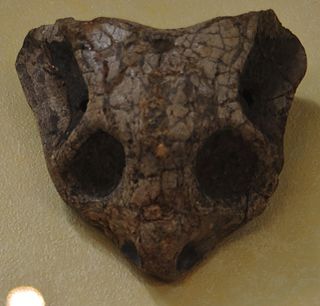
Cistecephalus is an extinct genus of dicynodont therapsid from the Late Permian of southern Africa. It was a small, specialised, burrowing dicynodont, possibly with habits similar to a modern mole. The head was flattened and wedge-shaped, the body long, and the forelimbs very strong, with similarities in structure to the forelimb of modern burrowing mammals.

Ochyroceratidae is a six-eyed spider family, with 165 described species in ten genera. They are common inhabitants of caves and the tropical forest litter of South Africa, the Caribbean, Asia and South America. Considered an ecological counterpart of the Linyphiidae of the northern temperate zone, species are especially diverse in the Indo-Pacific region.
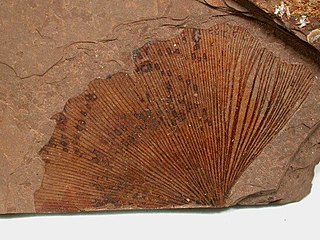
Ginkgo is a genus of highly unusual non-flowering seed plants. The scientific name is also used as the English name. The order to which it belongs, Ginkgoales, first appeared in the Permian, 270 million years ago, and is now the only living genus within the order. The rate of evolution within the genus has been slow, and almost all its species had become extinct by the end of the Pliocene; the exception is the sole living species, Ginkgo biloba, which is only found in the wild in China, but is cultivated across the world. The relationships between ginkgos and other groups of plants are not fully resolved.

A caiman is an alligatorid belonging to the subfamily Caimaninae, one of two primary lineages within Alligatoridae, the other being alligators.

Scotorepens is a genus of bats within the Vespertilionidae family. Species within this genus are widely distributed across Australia and to the north at Papua New Guinea and Indonesia.
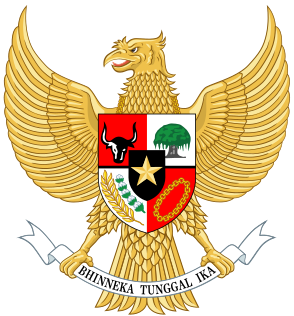
Throughout Indonesian history, the title of First Lady or, in an instance, First Gentleman has been used to refer to the wife or husband of the president of Indonesia. While the Constitution of Indonesia does not mention anything about the spouses of the president, it continues to hold significant influence in the Indonesian society.

Takaku Station is a railway station in the town of Nasu, Tochigi Prefecture, Japan, operated by the East Japan Railway Company.

Acheilognathus melanogaster is a species of brackish, freshwater ray-finned fish in the genus Acheilognathus. It is endemic to Japan.

Macrochelidae is a family of mites in the order Mesostigmata, containing the following genera and species:
Holostaspella is a genus of mites in the family Macrochelidae. There are about 12 described species in Holostaspella.
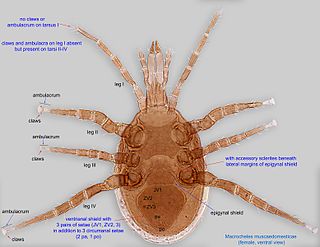
Macrocheles is a genus of mites in the family Macrochelidae. There are more than 80 described species in Macrocheles.
Eviphididae is a family of mites in the order Mesostigmata.
Thinoseius is a genus of mites in the family Eviphididae. There are about nine described species in Thinoseius.
Neopodocinum caputmedusae is a species of mite in the family Macrochelidae.
Neopodocinum halimunensis is a species of mite in the family Macrochelidae.
Neopodocinum subjaspersi is a species of mite in the family Macrochelidae.

Hemigrammocypris rasborella, the golden venus chub, is a species of cyprinid fish endemic to the islands of Honshu, Shikoku and Kyushu in Japan. It is found widely in lowland habitats, including ditches and ponds. It is listed as endangered on the Japanese Red List. H. rasborella is the only species in its genus, but there are significant genetic differences between some populations, comparable to those generally seen between closely related species. It reaches up to 7 cm (2.8 in) in length, but typically is 4–5 cm (1.6–2.0 in). It is a short-lived species that typically reaches an age of about one year. It is listed as endangered in the Red List of Threatened Fishes of Japan.
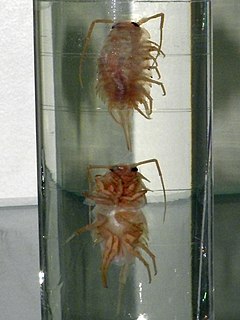
Ligia cinerascens is a woodlouse in the family Ligiidae.

The Tokyo bitterling is a temperate freshwater fish of the carp family (Cyprinidae). Taxonomically, it belongs to the subfamily Acheilognathinae.











